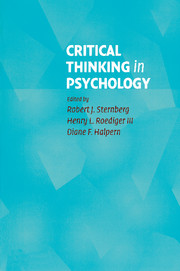Book contents
- Frontmatter
- Contents
- List of Illustrations and Tables
- List of Contributors
- Preface
- 1 The Nature and Nurture of Critical Thinking
- 2 Evaluating Experimental Research
- 3 Critical Thinking in Quasi-Experimentation
- 4 Evaluating Surveys and Questionnaires
- 5 Critical Thinking in Designing and Analyzing Research
- 6 The Case Study Perspective on Psychological Research
- 7 Informal Logical Fallacies
- 8 Designing Studies to Avoid Confounds
- 9 Evaluating Theories
- 10 Not All Experiments Are Created Equal
- 11 Making Claims in Papers and Talks
- 12 Critical Thinking in Clinical Inference
- 13 Evaluating Parapsychological Claims
- 14 Why Would Anyone Do or Believe Such a Thing?
- 15 The Belief Machine
- 16 Critical Thinking and Ethics in Psychology
- 17 Critical Thinking in Psychology
- Author Index
- Subject Index
- References
9 - Evaluating Theories
Published online by Cambridge University Press: 05 June 2012
- Frontmatter
- Contents
- List of Illustrations and Tables
- List of Contributors
- Preface
- 1 The Nature and Nurture of Critical Thinking
- 2 Evaluating Experimental Research
- 3 Critical Thinking in Quasi-Experimentation
- 4 Evaluating Surveys and Questionnaires
- 5 Critical Thinking in Designing and Analyzing Research
- 6 The Case Study Perspective on Psychological Research
- 7 Informal Logical Fallacies
- 8 Designing Studies to Avoid Confounds
- 9 Evaluating Theories
- 10 Not All Experiments Are Created Equal
- 11 Making Claims in Papers and Talks
- 12 Critical Thinking in Clinical Inference
- 13 Evaluating Parapsychological Claims
- 14 Why Would Anyone Do or Believe Such a Thing?
- 15 The Belief Machine
- 16 Critical Thinking and Ethics in Psychology
- 17 Critical Thinking in Psychology
- Author Index
- Subject Index
- References
Summary
All theories are false (Popper, 1959). So in one sense evaluating theories is a straightforward matter. However, some theories are more false than others. Furthermore, some theories have characteristics that tend to promote the advance of scientific knowledge. In this chapter, we examine what some of those characteristics are and how one goes about the process of identifying and building useful theories.
A theory is a concise statement about how we believe the world to be. Theories organize observations of the world and allow researchers to make predictions about what will happen in the future under certain conditions. Science is about the testing of theories, and the data that we collect as scientists should either implicitly or explicitly bear on theory.
There is, however, a great difference between theories in the hard sciences and theories in the soft sciences in their formal rigor. Formal theories are well established and incredibly successful in physics, but they play a lesser role in biology, and even less in psychology, where theories are often stated in verbal form. This has certainly been true historically, but some scientists, especially physicists, as well as laypeople, construe this fact to mean that formal theories are restricted to the hard sciences, particularly physics, while formalization is unattainable in the soft sciences. There is absolutely no reason to think so. Indeed, this is a pernicious idea that would permanently relegate psychology to second-class status.
- Type
- Chapter
- Information
- Critical Thinking in Psychology , pp. 143 - 159Publisher: Cambridge University PressPrint publication year: 2006
References
- 3
- Cited by



